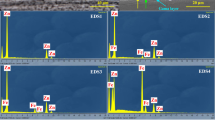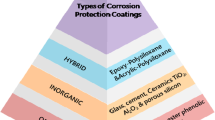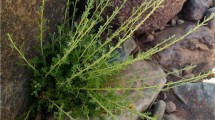Abstract
Ethylhexanoic acid-modified PDMS-ZnO nanocoatings containing varying dimensions of ZnO nanoparticles (30, 50 and 90 nm) were prepared. The main objective was to appraise the effect of varying dimensions of ZnO nanoparticles on the protective efficacy of ethylhexanoic acid-modified PDMS coating in aqueous solution of 3.5 wt% NaCl/Pseudomonas aeruginosa. Barrier properties and anti-corrosion performance of the coatings were evaluated by electrochemical impedance spectroscopy (EIS). Computational simulation techniques [quantum chemical computation (QCC) via density functional theory (DFT) and molecular dynamics (MD) simulation] were employed to provide molecular/atomistic level information on the chemical molecules responsible for corrosion protection performance and their adsorption phenomena. EIS results showed that the coating containing 30 nm ZnO nanoparticles maintained high impedance values in the order of 109 magnitude throughout the immersion periods. The obtained results were validated by wettability, scanning electron microscopy (SEM) and Fourier transform infrared (FTIR) spectroscopy results. The DFT calculations showed that PDMS and ethylhexanoic acid with energy gaps of 5.123 and 5.337 eV, respectively, are most responsible for the corrosion protection effect. The good adsorption of the coating containing 30 nm ZnO particles was validated by MD simulation result with adsorption energies (Eads) of − 2.28 kcal/mol, suggesting it is most susceptible for hydrophilic interaction.







Similar content being viewed by others
References
Zhao X, Liu X, Fan B, Zheng X (2022) Optimized anticorrosion of polypyrrole coating by inverted-electrode strategy: experimental and molecular dynamics investigations. Polymers (Basel). 14(7):1356. https://doi.org/10.3390/polym14071356
Nawaz M, Radwan AB, Kalambate PK, Laiwattanapaisal W, Ubaid F, Akbar HM, Shakoor RA, Kahraman R (2022) Synergistic behavior of polyethyleneimine and epoxy monomers loaded in mesoporous silica as a corrosion-resistant self-healing epoxy coating. ACS Omega 7(36):31700–31712. https://doi.org/10.1021/acsomega.2c01508
Najmi P, Keshmiri N, Ramezanzadeh M, Ramezanzadeh B (2021) Synthesis and application of Zn-doped polyaniline modified multi-walled carbon nanotubes as stimuli-responsive nanocarrier in the epoxy matrix for achieving excellent barrier-self-healing corrosion protection potency. Chem Eng J. https://doi.org/10.1016/j.cej.2021.128637
Rasitha TP, Nanda Gopala Krishna D, Thinaharan C, Vanithakumari SC, Philip J (2022) Optimization of coating parameters for fabrication of robust superhydrophobic (SHP) aluminum and evaluation of corrosion performance in aggressive medium. Prog Org Coat. https://doi.org/10.1016/j.porgcoat.2022.107076
Peng T, Xiao R, Rong Z, Liu H, Hu Q, Wang S, Li X, Zhang J (2020) Polymer nanocomposite-based coatings for corrosion protection. Chem Asian J. https://doi.org/10.1002/asia.202000943
Zhang M, Wang H, Nie T, Bai J, Zhao F, Ma S (2020) Enhancement of barrier and anti-corrosive performance of zinc-rich epoxy coatings using nano-silica/graphene oxide hybrid. Corros Rev 38(6):497–513. https://doi.org/10.1515/corrrev-2020-0034
Ding R, Chen S, Lv J, Zhang W, Zhao X-D, Liu J, Wang X, Gui T-J, Li B-J, Tang Y-Z, Li W-H (2019) Study on graphene modified organic anti-corrosion coatings: a comprehensive review. J Alloy Compd. https://doi.org/10.1016/j.jallcom.2019.07.256
Arukalam IO, Li Y (2019) Anticorrosion and barrier properties appraisal of poly(dimethylsiloxane)-ZnO nanocoating transition from superhydrophobic to hydrophobic state. J Coat Technol Res. https://doi.org/10.1007/s11998-018-00182-2
Elfadel RG, Refat HM, El-Wahab HA, Salem SS, Owda ME, Abdel Reheim MAM (2023) Preparation of new surface coating based on modified oil-based polymers blended with ZnO and CuZnO NPs for steel protection. Sci Rep 13:7268. https://doi.org/10.1038/s41598-023-34085-z
Arukalam IO, Meng M, Xiao H, Ma Y, Oguzie EE, Li Y (2018) Effect of perfluorodecyltrichlorosilane on the surface properties and anti-corrosion behavior of poly(dimethylsiloxane)-ZnO coatings. Appl Surf Sci 433:1113–1127. https://doi.org/10.1016/j.apsusc.2017.10.096
Habib S, Khan A, Ismail SM, Shakoor RA, Kahraman R, Ahmed EM (2023) Polymeric smart coatings containing modified capped halloysite nanotubes for corrosion protection of carbon steel. J Mater Sci 58:6803–6822. https://doi.org/10.1007/s10853-023-08437-z
Samad UA, Alam MA, Anis A, Sherif EM, Al-Mayman SI, Al-Zahrani SM (2020) Effect of incorporated ZnO nanoparticles on the corrosion performance of SiO2 nanoparticle-based mechanically robust epoxy coatings. Materials (Basel) 13(17):3767. https://doi.org/10.3390/ma13173767
Raha S, Ahmaruzzaman Md (2022) ZnO nanostructured materials and their potential applications: progress, challenges and perspectives. Nanoscale Adv 4:1868–1925. https://doi.org/10.1039/D1NA00880C
Verma S, Das S, Mohanty S, Nayak SK (2019) Development of multifunctional polydimethylsiloxane (PDMS)-epoxy-zinc oxide nanocomposite coatings for marine applications. Polym Adv Technol. https://doi.org/10.1002/pat.4656
Ibrahim NF, Abdullah WRW, Rooshde MS, Ghazali MSM, Nik WBW (2020) Corrosion inhibition properties of epoxy-zinc oxide nanocomposite coating on stainless steel 316L. Solid State Phenom 307:285–290. https://doi.org/10.4028/www.scientific.net/SSP.307.285
Gudkov SV, Burmistrov DE, Serov DA, Rebezov MB, Semenova AA, Lisitsyn AB (2021) A mini review of antibacterial properties of ZnO nanoparticles. Front Phys. https://doi.org/10.3389/fphy.2021.641481
Ramezanzadeh B, Attar MM, Farzam M (2011) A study on the anticorrosion performance of the epoxy–polyamide nanocomposites containing ZnO nanoparticles. Prog Org Coat 72:410–422. https://doi.org/10.1016/j.porgcoat.2011.05.014
Uribe PA, Ruiz J, Ortiz CC, Blanco SI, Gutierrez JA (2020) Antibacterial activity of ZnO nanoparticle coatings formed by electrophoretic deposition. J Phys Conf Ser 1541:012007. https://doi.org/10.1088/1742-6596/1541/1/012007
Kabaoglu E, Karabork F, Kayan DB, Akdemir A (2022) Improvement of anti-corrosion performance (surface and near the cut edge) and mechanical properties of epoxy coatings modified with nano, micro and hybrid ZnO particles. J Compos Mater. https://doi.org/10.1177/00219983221146846
Hosseini MGh, Aboutalebi K (2017) Electrochemical evaluation of corrosion protection performance of epoxy/polyaniline-imidazole modified ZnO nanocomposite coating on mild steel. Prog Color Color Coat 10:181–192
Pinto GM, Devadiga A (2022) Development of silane functionalized ZnO nanoparticles for enhancing anticorrosion application. Mapana J Sci 21(2):37–58. https://doi.org/10.12723/mjs.61.4
Javadi E, Ghaffari M, Bahlakeh G, Taheri P (2019) Photocatalytic, corrosion protection and adhesion properties of acrylic nanocomposite coating containing silane treated nano zinc oxide: a combined experimental and simulation study. Prog Org Coat 135:496–509. https://doi.org/10.1016/j.porgcoat.2019.06.039
Hang TTX, Dung NT, Truc TA, Duong NT, Truoc BV, Vu PG, Hoang T, Thanh DTM, Olivier M-G (2015) Effect of silane modified nano ZnO on UV degradation of polyurethane coatings. Prog Org Coat 79:68–74. https://doi.org/10.1016/j.porgcoat.2014.11.008
Hung HM, Linh DK, Chinh NT, Duc LM, Trung VQ (2019) Improvement of the corrosion protection of polypyrrole coating for CT3 mild steel with 10-camphorsulfonic acid and molybdate as inhibitor dopants. Prog Org Coat 131:407–416. https://doi.org/10.1016/j.porgcoat.2019.03.006
Liu R, Yao Q, Liu L, Meng F, Wang F (2022) Studies of different acid doped polyaniline incorporated into epoxy organic coatings on the Mg alloy. Prog Org Coat. https://doi.org/10.1016/j.porgcoat.2022.106774
Arukalam IO, Xu D, Li Y (2020) Antibacterial performance evaluation of hydrophobic poly(dimethylsiloxane)-ZnO coating using Pseudomonas aeruginosa. Chem Pap. https://doi.org/10.1007/s11696-020-01205-2
Mhadhbi N, Dgachi S, Ben Ahmed A (2023) Vibrational spectroscopies, global reactivity, molecular docking, thermodynamic properties and linear and nonlinear optical parameters of monohydrate arsenate salt of 4-aminopyridine. Chem Afr 6:1897–1912. https://doi.org/10.1007/s42250-023-00620-8
Chen D, Hu X, Zhang H, Yin X, Zhou Y (2015) Preparation and properties of novel polydimethylsiloxane composites using polyvinylsilsesquioxanes as reinforcing agent. Polym Degrad Stab 111:124–130. https://doi.org/10.1016/j.polymdegradstab.2014.10.026
Shi D, Li P, Cao B (2016) Preparation of PDMS/PVDF composite pervaporation membrane modified with hydrophobic TiO2 nanoparticles for separating formaldehyde solution. Polym Sci. https://doi.org/10.4172/2471-9935.100012
Lee J, Kim J, Kim H, Bae YM, Lee KH, Cho HJ (2013) Effect of thermal treatment on the chemical resistance of polydimethylsiloxane for microfluidic devices. J Micromech Microeng 23(3):035007. https://doi.org/10.1088/0960-1317/23/3/035007
Yang J, Zhou Q, Shen K, Song N, Ni L (2018) Controlling nanodomain morphology of epoxy thermosets templated by poly(caprolactone)-block-poly(dimethylsiloxane)-block-poly(caprolactone) ABA triblock copolymer. RSC Adv 8:3705–3715. https://doi.org/10.1039/c7ra12826f
Wang B, Liu X, Wang Y, Ding J, Wei S, Xia X, Liu M, Xu B (2022) Microstructure and anti-corrosion properties of supersonic plasma sprayed Al-coating with Nano-Ti polymer sealing on AZ91-Magnesium alloy. J Mark Res 21:2730–2742. https://doi.org/10.1016/j.jmrt.2022.10.086
Tan H, Guo Y, Wang J, Wang D, Cu Y (2021) The effect of additive particle size on the anti-corrosion behavior of PU coating. Anti-Corros Methods Mater. https://doi.org/10.1108/ACMM-08-2020-2359
Dhakal DR, Kshetri YK, Chaudhary B, Kim T-H, Lee SW, Kim BS, Song Y, Kim HS, Kim HH (2022) Particle-size-dependent anticorrosion performance of the Si3N4-nanoparticle-incorporated electroless Ni-P coating. Coatings 12(1):9. https://doi.org/10.3390/coatings12010009
Liu F, Yang L, Han E (2010) Effect of particle sizes and pigment volume concentrations on the barrier properties of polyurethane coatings. J Coat Technol Res 7:301–313. https://doi.org/10.1007/s11998-009-9203-3
Jordaan MA, Ebenezer O, Mthiyane K, Damoyi N, Shapi M (2021) Amide imidic prototropic tautomerization of efavirenz, NBO analysis, hyperpolarizability, polarizability and HOMO–LUMO calculations using density functional theory. Comput Theor Chem 1201:113273. https://doi.org/10.1016/j.comptc.2021.113273
Javan M, Soltani A, Ghasemi AS, Tazikeh E, Gholami N, Balakheyli H (2017) Ga-doped and antisite double defects enhance the sensitivity of boron nitride nanotubes towards Soman and Chlorosoman. Appl Surf Sci 411:1–10. https://doi.org/10.1016/j.apsusc.2017.03.187
Dagdag O, Hsissou R, El Harfi A, Berisha A, Safi Z, Verma C, Ebenso EE, Ebn Touhami M, El Gouri M (2020) Fabrication of polymer-based epoxy resin as effective anti-corrosive coating for steel: computational modeling reinforced experimental studies. Surf Interfaces. https://doi.org/10.1016/j.surfin.2020.100454
Acknowledgements
The authors appreciate the support by the Africa Centre of Excellence in Future Energies and Electrochemical Systems (ACE-FUELS), Federal University of Technology Owerri (FUTO), Nigeria. Grant Number, [NUC/ES/507/1/304].
Author information
Authors and Affiliations
Contributions
IOA conceptualized and designed the study. INU conducted the experimental work and collated the data. Computational simulation studies and data collection were performed by BT and OD. IOA and EEO supervised the study, analyzed the results, and wrote the first draft of the manuscript. All authors reviewed and approved the final manuscript.
Corresponding author
Ethics declarations
Conflict of interest
The authors declare there are no competing financial or personal or belief interests regarding the publication of this article.
Rights and permissions
Springer Nature or its licensor (e.g. a society or other partner) holds exclusive rights to this article under a publishing agreement with the author(s) or other rightsholder(s); author self-archiving of the accepted manuscript version of this article is solely governed by the terms of such publishing agreement and applicable law.
About this article
Cite this article
Arukalam, I.O., Uzochukwu, I.N., Tüzün, B. et al. Influence of ZnO Nanoparticle Size on Barrier Performance and Corrosion Protection of Poly(dimethylsiloxane)-Coated Q235 Steel in Chloride Environment: Bode and Computational Simulation Investigations. Chemistry Africa 7, 853–863 (2024). https://doi.org/10.1007/s42250-023-00791-4
Received:
Accepted:
Published:
Issue Date:
DOI: https://doi.org/10.1007/s42250-023-00791-4




